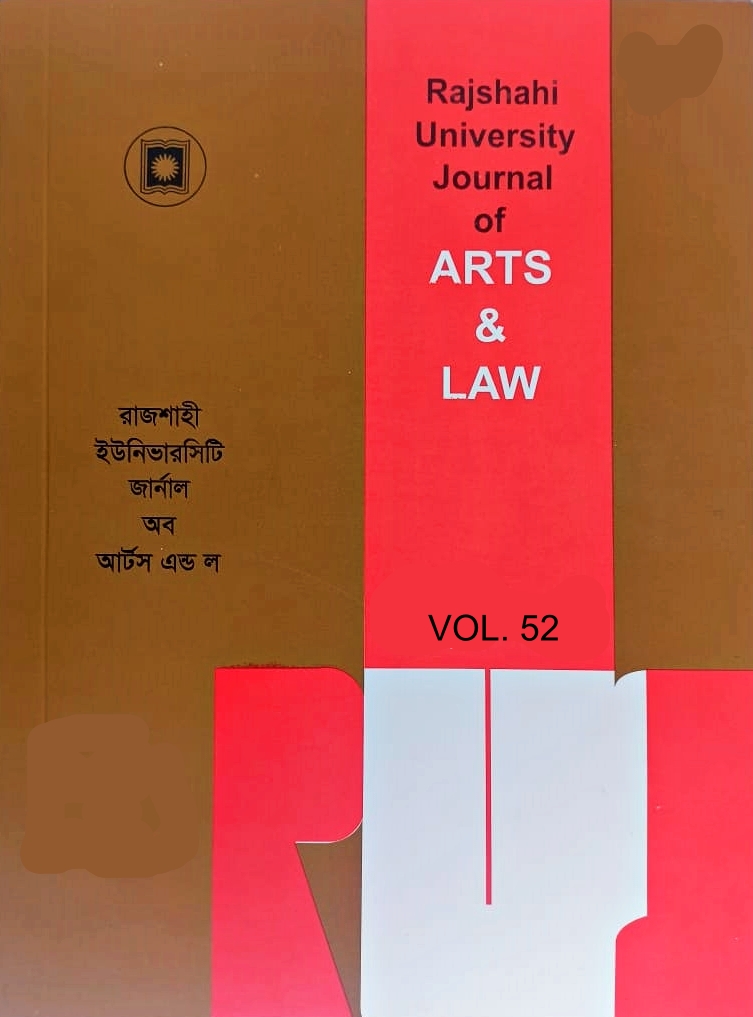Gananayaka: A Beacon of Hope against Despair
গণনায়ক: নৈরাশ্যের বিপরীতে আশার আলোকবর্তিকা
DOI:
https://doi.org/10.64102/rujal.0707Keywords:
Mujib, Gananayaka, History, Motherland, War, Killers, Bangali, PatriotismAbstract
In order to keep the ethical ideals of the Bengali nation moving against the brutality of the 1975s, the textual essay Gananayaka (1976) by Sabyasachi playwright Syed Shamsul Haque (December 27, 1935-September 27, 2016) is a proof of hope against despair. Gananayaka is the central character of the play Osman, who is addressed as Gananayaka in the play. After the independence of the country in 1971, Gananayaka, discussed in the play, took over the power of independent Bengal. However, his state power was short-lived. History of Bengal has witnessed that he faced tough conspiracies and he was able to overcome the negative forces to counter those conspiracies. Playwright Syed Haque has been able to create metaphors very well with the story of the assassination of Gananayak and the picture of the overall situation in Bangladesh. The father of the nation, which in the eyes of the common man was only lost by murder, languishing in the stagnation of the unclaimed, was able to carry the seeds of his dream later with great prudence. There has been a lot of research on this great man of history, but very little research work has been done on Syed Haque's Gananayaka texts. In the socio-economic and political life of the Bengali nation, the group of assassins tried to spread doubts and confusion in the dark night of 75, collecting the seeds of research from there, the budding researcher will be active in carrying out the work. It should be noted that drama is created in a mixed way of imagination and reality. Although it does not directly apply reality, there is no room to express doubt about the artistic quality, but the reader does not have to suffer from any historical confusion with the Gananayaka play. Why the assassins were forced to go into hiding after the assassination of Gananayaka, is a very significant subject in the essay of Vakshyaman. In analyzing the political situation of the time, the contemporary researcher will be primarily concerned with the inquiry, in what way a leader becomes a republican. The essayist will conduct a research process based on a mixed method analysis of information and data subject to third party positions in a very conscious manner. The result will attempt to prove that Syed Haque's Gananayaka (1976) is clearly capable of instilling hope as opposed to despair.
Downloads
References
শেখ মুজিবুর রহমান, অসমাপ্ত আত্মজীবনী, ঢাকা, ইউনিভার্সিটি প্রেস লিমিটেড, ২০১৯।
“শেখ মুজিবুর রহমান: ছবিতে তাঁর জীবনের গুরুত্বপূর্ণ কিছু মুহূর্ত”. www.bbc.com. BBC NEWS বাংলা, Published August 15, 2020. accessed on 29 October, 2022.
Chowdhury, Rahman, et al. “Bangabandhu Sheikh Mujibur Rahman & Founder of a Nation: European Modern Studies Journal, Vol-4, no-3, 2020.
নীরদচন্দ্র চৌধুরী। আত্মঘাতী বাঙালী। কলকাতা: মিত্র ঘোষ পাবলিশার্স প্রা: লি:, ১৯৮৮।
অমর্ত্য সেন। বাংলা সংস্কার, সম্পাদনা-অনির্বাণ চট্টোপাধ্যায়, কুমার রানা। নীতি ও ন্যায্যতা। কলকাতা: আনন্দ পাবলিশার্স, ২০১৩।
মুনতাসীর মামুন। বঙ্গবন্ধু কীভাবে আমাদের স্বাধীনতা এনেছিলেন। ঢাকা: মাওলা ব্রাদার্স, ফেব্রুয়ারি- ২০১৩।
সম্পাদনা-তপন কুমার দে। রক্তাক্ত ১৫ আগস্ট ১৯৭৫। ঢাকা: তা¤্রলিপি, ফেব্রুয়ারি ২০১০।
আবদুল গাফফার চৌধুরী। ইতিহাসের রক্তপলাশ, পনেরই আগস্ট পঁচাত্তর। ঢাকা: জ্যোৎস্না পাবলিশার্স, ২০১৭।
সিরাজুল ইসলাম। বাঙালীর জাতীয়তাবাদ। ঢাকা: দি ইউনিভার্সিটি প্রেস লিমিটেড , ২০০০।
সিমুন্ড ফ্রয়েড। অনুবাদ- আলীফ হোসেন। একটি দৃষ্টিভ্রমের ভবিষ্যত। ঢাকা: সংহতি, ফেব্রুয়ারি ২০১৩।
অস্ট্রিক আর্যু। আন্তর্জাতিক গণমাধ্যমে মুক্তিযুদ্ধ ও বঙ্গবন্ধু শেখ মুজিব। ঢাকা: অনিন্দ্য প্রকাশ, ফেব্রুয়ারি ২০০৯।
Downloads
Published
Issue
Section
License
Copyright (c) 2025 Rajshahi University Journal of Arts & Law

This work is licensed under a Creative Commons Attribution 4.0 International License.





